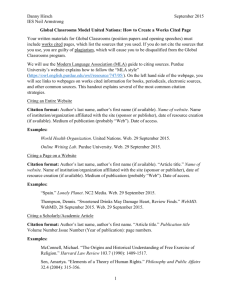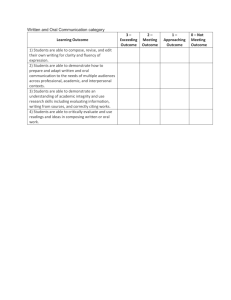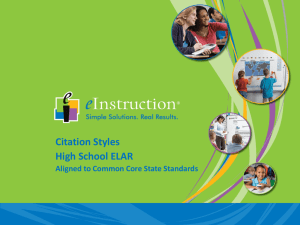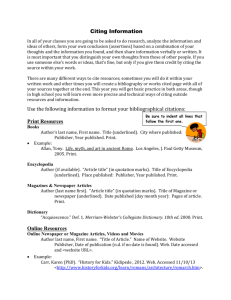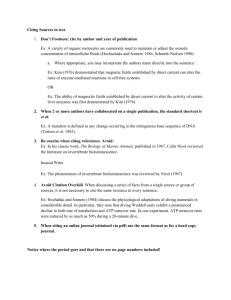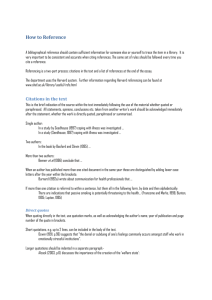references for PG handbook 08-09 (new
advertisement
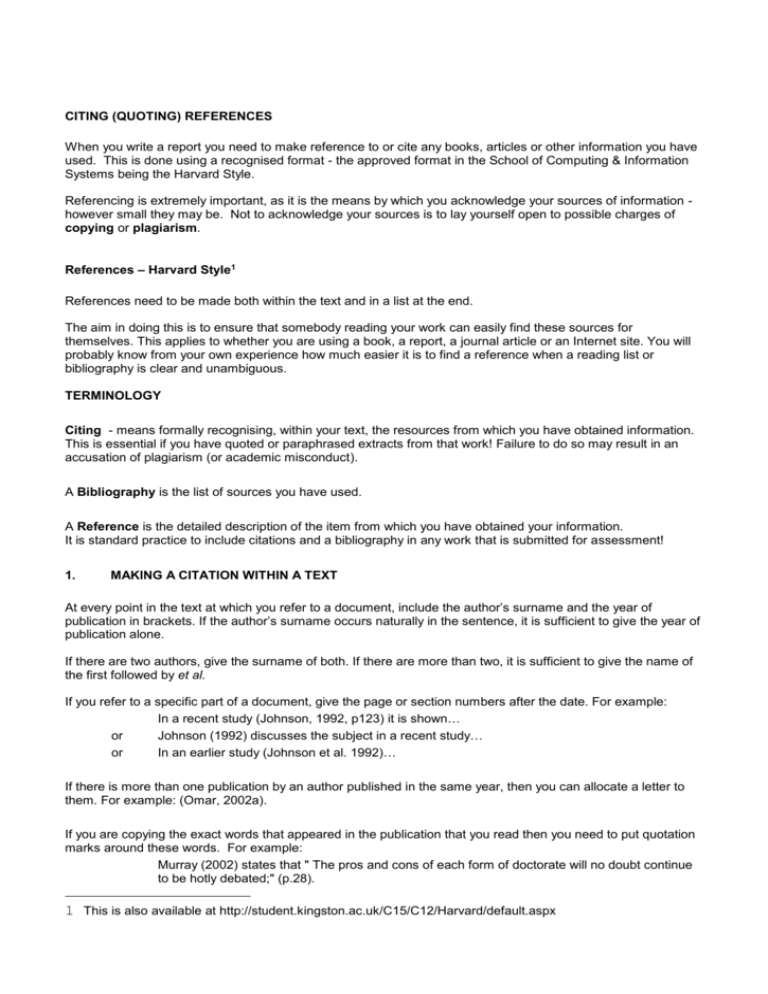
CITING (QUOTING) REFERENCES When you write a report you need to make reference to or cite any books, articles or other information you have used. This is done using a recognised format - the approved format in the School of Computing & Information Systems being the Harvard Style. Referencing is extremely important, as it is the means by which you acknowledge your sources of information however small they may be. Not to acknowledge your sources is to lay yourself open to possible charges of copying or plagiarism. References – Harvard Style1 References need to be made both within the text and in a list at the end. The aim in doing this is to ensure that somebody reading your work can easily find these sources for themselves. This applies to whether you are using a book, a report, a journal article or an Internet site. You will probably know from your own experience how much easier it is to find a reference when a reading list or bibliography is clear and unambiguous. TERMINOLOGY Citing - means formally recognising, within your text, the resources from which you have obtained information. This is essential if you have quoted or paraphrased extracts from that work! Failure to do so may result in an accusation of plagiarism (or academic misconduct). A Bibliography is the list of sources you have used. A Reference is the detailed description of the item from which you have obtained your information. It is standard practice to include citations and a bibliography in any work that is submitted for assessment! 1. MAKING A CITATION WITHIN A TEXT At every point in the text at which you refer to a document, include the author’s surname and the year of publication in brackets. If the author’s surname occurs naturally in the sentence, it is sufficient to give the year of publication alone. If there are two authors, give the surname of both. If there are more than two, it is sufficient to give the name of the first followed by et al. If you refer to a specific part of a document, give the page or section numbers after the date. For example: In a recent study (Johnson, 1992, p123) it is shown… or Johnson (1992) discusses the subject in a recent study… or In an earlier study (Johnson et al. 1992)… If there is more than one publication by an author published in the same year, then you can allocate a letter to them. For example: (Omar, 2002a). If you are copying the exact words that appeared in the publication that you read then you need to put quotation marks around these words. For example: Murray (2002) states that " The pros and cons of each form of doctorate will no doubt continue to be hotly debated;" (p.28). 1 This is also available at http://student.kingston.ac.uk/C15/C12/Harvard/default.aspx Longer quotations should be indented in a separate paragraph:Murray (2002) describes the drawing together of an argument thus:"in the doctoral process ideas flow freely and even the writing can be free of structures at many stages. However, there is a need to block the freeflow and design an endpoint to the thesis or a part of the thesis. Like a clot, closure can be dissolved. Like a time plan. it will be revised in light of events and feedback."(p.174) 2. BIBLIOGRAPHIES/LISTS OF REFERENCES AT THE END OF A TEXT Reference list: The full references to cited documents should be given in a reference list titled References at the end of the text, arranged in alphabetical order by author’s surname, and then by year of publication. Cite elements of the reference in the order shown below and be consistent in your punctuation and typographic style (italics can be used instead of underlining). Bibliography: You should generally include texts that have influenced the work but are not cited directly in an additional list titled Bibliography. This list should include all the works cited in the previous References List and any additional uncited works. 3. CITING PRINTED MATERIAL Citing Books or Reports You should include: Author(s)/editor(s). (Year of publication). Title of publication, Edition if not first. Place of publication: Publisher Example: Deitel, Harvey & Deitel, Paul. (2001), C++ How to Program. 3rd Edition. Upper Saddle River, N.J.: Prentice Hall If you are referring to a numbered report, give the report number at the end. Citing Journal Articles You should include: Author(s) of article. (Year of publication). Title of article. Title of journal, volume no. (part no.), page numbers. Example: Hausser, Roland. (2001) Database semantics for natural language. Artificial Intelligence, 130(1), pp. 27-74 For daily or weekly publications, you need only give the date of the issue rather than the volume and part numbers. Citing Separate Contributions in Books or Conference Proceedings You should include: Author(s) of contribution. (Year of publication). Title of contribution. In: Author(s)/editor(s). Title of overall publication. Edition if not the first. Place of publication: Publisher. Page numbers. Example: Hutchison, C.S. & Rosenberg, D. (1993) Conflict and Co-operation in KnowledgeIntensive Computer-Supported Co-operative Work, in S. Easterbrook (ed.), CSCW: Cooperation or Conflict? London: Springer-Verlag, pp. 102-122 Carribault, P. Cohen, A. (2004) Applications of storage mapping optimization to register promotion. In: ICS '04: Proceedings of the 18th annual international conference on Supercomputing. Malo, France June 26 - July 01. USA. Association of Computing Machinery. pp. 247-256. Citing Illustrations You should include: Author(s)/editor(s). (Year of publication). Title of book. Place: Publisher. Page number, illus./fig./table/map. (depending on the type of illustration you wish to cite). Example: Flanders, Vincent and Willis, Michael. (1998). Web pages that suck: learn good design by looking at bad design San Francisco: Sybex. p.22, fig. 2.2 Citing Student projects You should include: Author(s) Title of Project, Degree submitted for, University, Year of publication. Example 4. Tate, T. Internet enabled scheduling calendaring and messaging information system. Project report submitted for B.Sc., Kingston University, 1999. CITING ELECTRONIC MATERIAL When citing information from electronic material you will need to include enough information to enable a reader to find the same material. Many website addresses are long and include control codes, in these cases it is acceptable to just include the main body of the address so that a reader can identify the website from where the material came. If possible, you should cite the date the web document was last updated but if this is not available then use the copyright date. As websites are a changing media you need to cite the date you accessed the site. To avoid any confusion with full stops and commas in the web address, it is now common to use < and > to show the beginning and end of an URL. If the material (e.g. website, CD ROM, video) does not have an explicit author, then treat the material as an anonymous work and use the title as the first piece of information in the reference. It is acceptable to use the corporate author as the author of all the pages on the site (e.g. Microsoft, Adobe etc) It is a good idea to print out a copy of any potentially temporary material (such as emails) as you may need to prove a source after it has been removed from the website. Citing Electronic Journal Articles You should include: Author(s)/editor(s). (Year of publication). Title of article. Title of journal. [type of medium]. volume no. (part no), page numbers. <Web address of the article>. [Date accessed]. Example: Cramer, S.B. (1998). A united approach to healthy schools. British Food Journal. [Internet]. 100 (8), p. 380-384. <http://www.emerald-library.com>. [Accessed 11th January 2001]. Citing Electronic books You should include: Author(s)/editor(s). (Year of publication). Title of book. Name of e-book supplier [Online]. <url> [Date accessed] Example Duff, A.E.C. (2006) Interaction with computers. Safari [Online] < http://proquest.safaribooksonline.com> [Accessed 22nd February 2008] Citing www Documents You should include: Author. (Year of publication). Title of document. <URL> [date accessed]. Example: The space science enterprise: integrated technology strategy. (1998) <http://spacescience.nasa.gov/osstech/sse/>. [Accessed 11th January 2001]. Citing from Blackboard You should include: Author. (Year of publication). “Title of item”. Name of academic module [Online]. <url> [Date accessed] Example: Grover, C. (2008) “Week 2: Programming tools” Programming essentials [Online]. <http://lms.kingston.ac.uk/> [Accessed August 28th 2007] Citing CD ROMs You should include: Author/editor. (Year of publication). Title of CD ROM. [CD ROM]. Place of publication: Publisher. Example: Interactive skeleton. (1998). [CD ROM]. London: Mosby: Primal Pictures. Citing E-mail Discussion Lists You should include: Author/editor. (Year). Title of message. Discussion list name and date of message. [medium]. <e-mail list address>.[Date accessed] Example: Pinto, A.J. (2000). Ungodly Global Warming, Genocide, World Hunger, and Hope. ecological-genetics October 2000. [Internet Discussion List]. < ecologicalgenetics@mailbase.ac.uk> [accessed 12th January 2001]. Citing a Newsgroup/Bulletin Board Message You should include: Author. (Year). “Subject of message”, Discussion group Date posted [Online] Available email address Example: Yee, A. (2001). Solar power farm begins gamma ray astronomy. Sci.astro January 2001. [Online]. Available email: jlazio@patriot.net Citing Personal E-mail If you wish to cite a personal e-mail you must have the sender’s permission to quote their message. You should include: Sender (Sender’s e-mail address) (Day Month Year). Subject of message. E-mail to recipient (Recipient’s e-mail address). Example: Doe, J. (j.doe@kingston.ac.uk) (12th January 2001). Survey results. Personal e-mail to J. Bloggs (j.bloggs@kingston.ac.uk). Citing Online Images You should include: Author/artist (year of publication) Title of image. [Online image]. <URL>. Filename including the extension. [Date accessed] Example: CS80 Circuit Diagram 1. (1999) [Online image].<http://bermuda.ucd.ie/bridge/cs80.html> |cs80_circ1.jpg. [accessed 11th Sept 2001] Citing DVDs You should include: Example: 5. Title of film (Year of distribution) Director [DVD] Place of distribution: Distribution company American President (1995) R Reiner [DVD]. California: Universal Studios GLOSSARY The following outlines some common conventions used in bibliographies. They are not a part of the Harvard style but may be useful to know when reading the work of others. Ibid. (Latin). This is used to when referring to the preceding reference in the bibliography. Example: 1. Haines, P.J. (1995). Thermal methods of analysis. London: Chapman & Hall. 2. Ibid. p. 93 Op. Cit. (Latin). This is used after an author’s name to mean the same work as last cited for this author. Example: 1. Haines, P.J. (1995). Thermal methods of analysis. London: Chapman & Hall. 2. Rendell, D. (1987). Fluorescence and phosphorescence. Chichester: John Wiley & Sons. 3. Haines, P.J. op.cit. p. 57. Et al. (Latin). Where there are more than two authors, et al. is used after the first author to mean ‘and others’. Example: Ellis, T. et al. (1994). Fortran 90 programming. Harlow: Addison-Wesley. 6. BIBLIOGRAPHY The following documents have been used in the compilation of this guide. Dee, M. (1998). Quote, unquote: the Harvard style of referencing published material. [Internet]. Leeds: Leeds Metropolitan University. <http://www.lmu.ac.uk/lss/ls/docs/harvfron.htm>. [accessed 11th January 2001]. Pears, R. and Shields, G. (2005) Cite them right: the essential guide to referencing and plagiarism. Newcastle upon Tyne: Pear Tree Books Shields, G. and Walton, G. (1998). Cite them right! [Internet]. Newcastle: University of Northumbria at Newcastle. < http://www.unn.ac.uk/central/isd/cite/>. [accessed 19th January 2001]. University of Sheffield Library. (2000). Citing electronic sources of information. [Internet]. Sheffield: University of Sheffield. <http://www.shef.ac.uk/~lib/libdocs/hsldvc2.html>. [accessed 11th January 2001].
